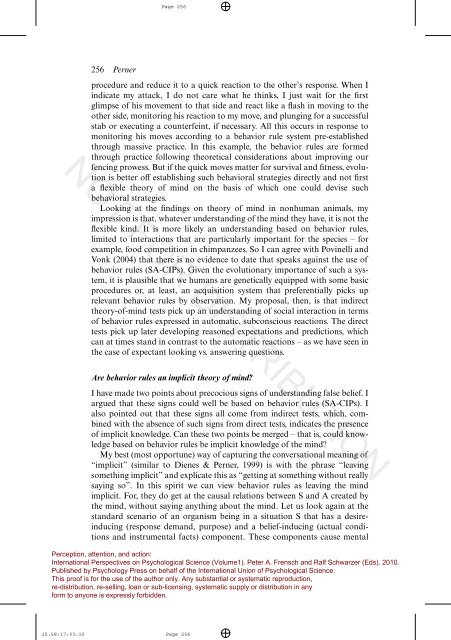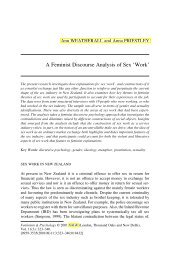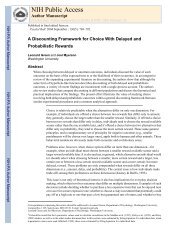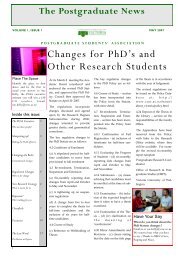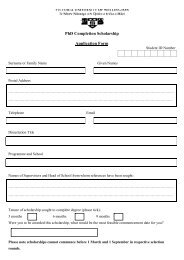Perner 2010.pdf
Perner 2010.pdf
Perner 2010.pdf
Create successful ePaper yourself
Turn your PDF publications into a flip-book with our unique Google optimized e-Paper software.
Page 256256 <strong>Perner</strong>procedure and reduce it to a quick reaction to the other’s response. When Iindicate my attack, I do not care what he thinks, I just wait for the firstglimpse of his movement to that side and react like a flash in moving to theother side, monitoring his reaction to my move, and plunging for a successfulstab or executing a counterfeint, if necessary. All this occurs in response tomonitoring his moves according to a behavior rule system pre-establishedthrough massive practice. In this example, the behavior rules are formedthrough practice following theoretical considerations about improving ourfencing prowess. But if the quick moves matter for survival and fitness, evolutionis better off establishing such behavioral strategies directly and not firsta flexible theory of mind on the basis of which one could devise suchbehavioral strategies.Looking at the findings on theory of mind in nonhuman animals, myimpression is that, whatever understanding of the mind they have, it is not theflexible kind. It is more likely an understanding based on behavior rules,limited to interactions that are particularly important for the species – forexample, food competition in chimpanzees. So I can agree with Povinelli andVonk (2004) that there is no evidence to date that speaks against the use ofbehavior rules (SA-CIPs). Given the evolutionary importance of such a system,it is plausible that we humans are genetically equipped with some basicprocedures or, at least, an acquisition system that preferentially picks uprelevant behavior rules by observation. My proposal, then, is that indirecttheory-of-mind tests pick up an understanding of social interaction in termsof behavior rules expressed in automatic, subconscious reactions. The directtests pick up later developing reasoned expectations and predictions, whichcan at times stand in contrast to the automatic reactions – as we have seen inthe case of expectant looking vs. answering questions.NOT FOR DISTRIBUTIONAre behavior rules an implicit theory of mind?I have made two points about precocious signs of understanding false belief. Iargued that these signs could well be based on behavior rules (SA-CIPs). Ialso pointed out that these signs all come from indirect tests, which, combinedwith the absence of such signs from direct tests, indicates the presenceof implicit knowledge. Can these two points be merged – that is, could knowledgebased on behavior rules be implicit knowledge of the mind?My best (most opportune) way of capturing the conversational meaning of“implicit” (similar to Dienes & <strong>Perner</strong>, 1999) is with the phrase “leavingsomething implicit” and explicate this as “getting at something without reallysaying so”. In this spirit we can view behavior rules as leaving the mindimplicit. For, they do get at the causal relations between S and A created bythe mind, without saying anything about the mind. Let us look again at thestandard scenario of an organism being in a situation S that has a desireinducing(response demand, purpose) and a belief-inducing (actual conditionsand instrumental facts) component. These components cause mentalPerception, attention, and action:International Perspectives on Psychological Science (Volume1). Peter A. Frensch and Ralf Schwarzer (Eds). 2010.Published by Psychology Press on behalf of the International Union of Psychological Science.This proof is for the use of the author only. Any substantial or systematic reproduction,re-distribution, re-selling, loan or sub-licensing, systematic supply or distribution in anyform to anyone is expressly forbidden.15:58:17:03:10Page 256


